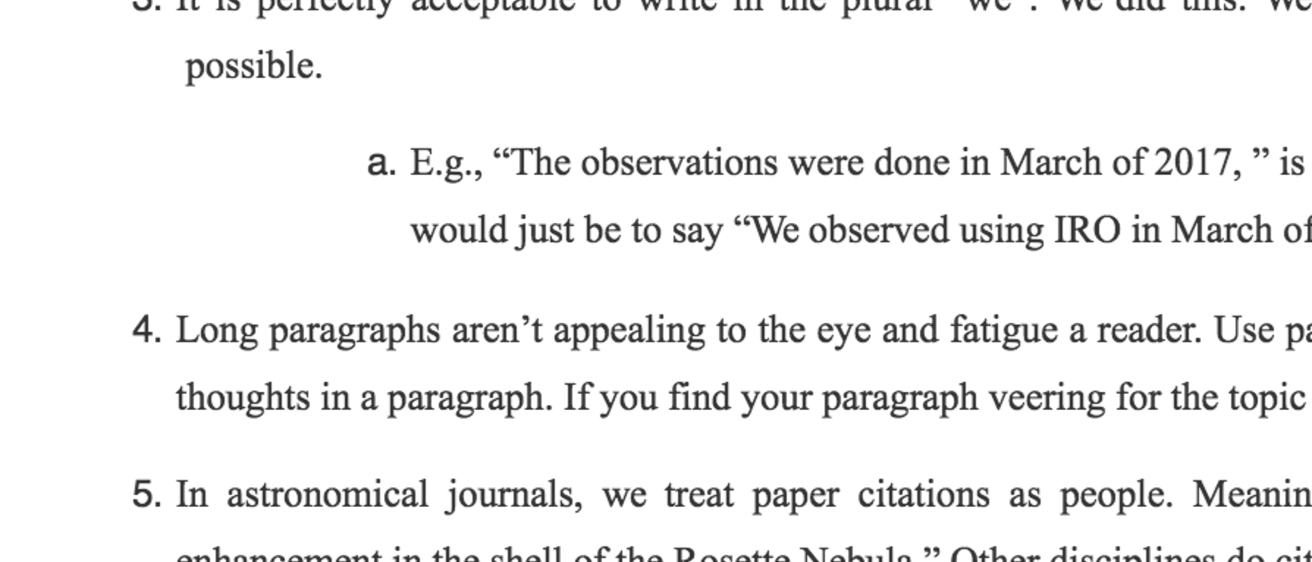Resources: Writing a Research Paper
Structure of a Paper
A good science paper has the following:
- Abstract
The Abstract is a “tag line” style summary to your paper. It is gives the relevant results, implications, and boils down the entire paper to a single paragraph. Sometimes it’s easiest to write this last. - Introduction
The introduction is where you summarize and highlight any relevant work to your topic. For example, if your paper is over supernova, it would be good to summarize the current state of knowledge concerning supernova. Keep it topical to the paper though. The introduction section should have a plethora of references, as the text is not what you have done, but what the current understanding is. At the end of your introduction, you should include a paragraph stating your intent, i.e., your science question. This section usually requires a lot of reading and literature searches. Take advantage of the https://ui.adsabs.harvard.edu/ website to do introductory literature searches. - Observations
The observation section is where you mechanically list telescope details, date of observations, technical aspects of your observational scheme, and other particular observation information. For example, if you implemented a particular tracking scheme for the telescope, this is the place to mention it. Generally, you should include a table to make it easy for the reader to locate this technical information. - Data Analysis
The Data analysis section gives the equations, programs, and analysis techniques used to find your results. This section can be combined with the Results section, though you should avoid the temptation to give your results immediately. - Results
In the results section, there should be representative figures, lightcurves, relevant plots, tables of data, etc., to showcase your results. Everything should have error estimates with it. - Discussion
The discussion section (sometimes combined with results), is where you interpret your data. What is the science question you asked and how does your data answer it? What are the limitations of your data? What is needed to answer the question your data brings up? How do your results advance our understanding of this topic? How do your results compare to others in the literature? - Summary and Conclusions
(a) Finally, your summary should introduce no new information, only a recap of your paper. I am a huge fan of bullet point summaries. - Bibliography
Tips for Good Paper Writing
Here are some general tips for writing scientific papers:
- It is no secret that despite the painstaking work put into papers, readers usually read the abstract, the figure and table captions and then the summary at first pass. If they find those compelling, they will then read the rest of the sections.
- Scientific writing is cold and mechanical. Leave off the flower language and phrases. Instead, make your sentences as compact as possible while giving the most information. In most academic journals, you pay per word.
For example: “on the other hand” - It is perfectly acceptable to write in the plural “we”. We did this. We observed this. You should avoid using passive voice as much as possible.
E.g., “The observations were done in March of 2017,” is a moderately acceptable use of passive voice. A better way would just be to say “We observed using IRO in March of 2017.” - Long paragraphs aren’t appealing to the eye and fatigue a reader. Use paragraphs as natural breaks and have a topic sentence to guide your thoughts in a paragraph. If you find your paragraph veering for the topic sentence, it’s time for a new paragraph.
- In astronomical journals, we treat paper citations as people. Meaning, we write: “Costa et al. (2016) argued for a magnetic field enhancement in the shell of the Rosette Nebula.” Other disciplines do citations differently.
- Use strong words to describe your work but maintain a skeptical outlook. So, you can use phases like “we show” and “we find” in lieu of phrases of “we think this shows”. The mentality is different and shows confidence in your work. Of course, you should always offer reasons why your interpretation might be wrong and a thorough error analysis.
- A null result is still a result. Do not be discouraged by the lack of “amazing, ground breaking results” that stuff ended in the ’90s anyway.
